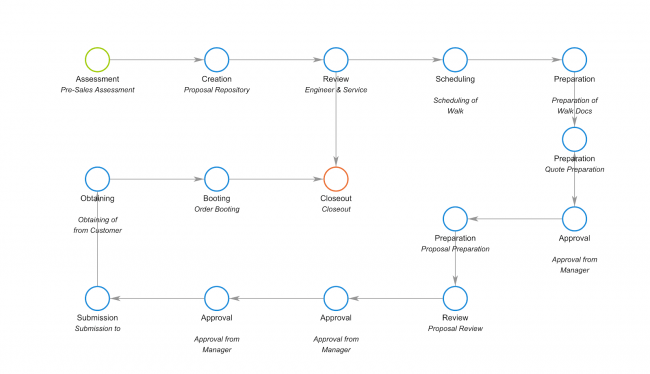Business Process Management (BPM) is a systematic approach to optimizing a company’s workflow for increased effectiveness, reliability, and understanding. You try to improve the systems that run your business so that it works more efficiently and profitably. These days, such understanding of the importance of business process management and more specifically the advantages of business process management is crucial for success. By continuously improveing processes, companies can gain a competitive edge.
Business process management systems are not easy to describe, but their impact is accurate in its focus: To improve operations processes and results, enhance productivity, and increase sales. The focus of this article is on significant positive impacts of BPM integration for companies of every size. This also addresses the core questions – ‘Why BPM?’ and ‘Why business process management in the 2024-2025 era?’ The reach of benefit of BPM software is towards all the facets of the business.
Good business process management delivers tangible business process management benefits like cost efficiency, leading to decreased expenses and increased revenue. But the intangible benefits, realized over the long term, are equally crucial. They empower companies to adapt quickly to changing market conditions, outpace competitors, and thrive.
Let’s delve into the top 10 advantages that business process management technology offers your organization, and how business process management tools can transform your operations. By identifying bottlenecks, companies can maximize the benefits of bpm. Understanding the different types of business process is also key.
The Top 10 BPM Benefits for Your Business:
Cost Efficiency: Streamline Operations and Boost Profitability
Simply cutting budgets is no longer a sustainable strategy. Businesses must ensure that costs already incurred and revenues produced by them are efficiently utilized. BPM drives cost efficiency by streamlining business operations, automating routine work, enhancing product quality, and reducing corporate risks. In 2025, BPM is no longer a luxury, but a necessity for companies seeking to maintain a competitive edge. Companies need to increase efficiencies.” The advantages of process management cannot be overstated.
For example, implementing BPM software can automate invoice processing, reducing manual labor and human errors.
Business Agility: Adapt and Thrive in a Dynamic Market
A key trend in BPM is the development of nimble processes that respond to organizational learning in the marketplace. Flexibility is a primary business process management goal, alongside cost efficiency. This demands ultra-flexible business process management tools that are easy to design, change, and deploy. Understanding business process management use cases is crucial for maximizing value. Business process management advantages include the ability to quickly adapt to changing circumstances.
Business agility incorporates several key elements:
-
- Process Management: With CMW Platform, process management comes in the form of visual workflows that you can change on-the-fly. You can re-use workflows wherever you need to and customize them as you go.
- Rule Management: Staying governed, visible, and compliant in an unstructured, collaborative environment.
- Integration and Automation: Seamlessly connecting tasks, cases, and projects within a business process management system.
- Continual Optimization and Scaling: Implementing quick wins and scaling BPM incrementally, which enables businesses to reach new heights.
With agile BPM implementations you can quickly adapt to new regulations, market trends, or customer demands. [Provide a specific example of a company using BPM for agility here. This often involves creating effective process maps.
Compliance Ease and Visibility: Stay Ahead of Regulations
Changes in legislation can lead to unforeseen costs for companies without a flexible compliance system. BPM systems allow companies to build compliance into their business practices by integrating department-specific applications with the organization as a whole. This allows for automated reports demonstrating compliance in a cost-efficient way. In order to gain efficiency from a business process management system, companies need to understand its core benefits.
For instance, BPM can automate data collection and reporting for GDPR compliance, reducing the risk of fines and penalties. [Source: Link to relevant compliance documentation/article] This helps reduce errors and ensures regulatory adherence. The advantages of business process automation are substantial in this area.
Customer Focus: Exceed Expectations in the Web 3.0 Era
Savvy customers demand proof-of-concept processes that demonstrate how their needs will be met through self-service capabilities. Business process management helps organizations combine people with technology to acquire and retain satisfied customers by personalizing interactions and providing easy access to information. This is made possible by workflow management.
Leverage BPM to map customer journeys, identify pain points, and design streamlined processes that enhance the customer experience. [Source: Link to customer experience statistic or article]. This leads to more informed decisions. By understanding what are the benefits of business process management in this context, companies can create exceptional customer experiences.
Staff Satisfaction
With clear and automated workflows employees tend to avoid manual tasks and instead focus on other activities that require more attention. This leads to increased job satisfaction and reduced employee turnover. [Source: Link to statistic about employee satisfaction and process automation] This is one of the key benefits of business process automation.
Efficiency and Productivity
BPM is a major contributor to the productivity and efficiency objectives of business enterprises relative to their goals. It is important to appreciate the role of process management in this regard. Measuring and monitoring processes, establishing process excellence, and optimizing workflows leads to greater process efficiency. The ability to quickly identify and remove tasks that bring little value boosts productivity overall. Understanding the importance of process management in this context is critical.
By using BPM to automate the approval and routing of documents, the time needed for each task to be completd is greatly reduced, which increases the overall productivity of the group.
Reduced Micromanagement
BPM eliminates the need for micromanagement by providing clear documentation of standard operating procedures (SOPs) and assigning responsibilities. Employees can complete tasks confidently without constant supervision.
Single Digital Environment
A good BPM tool serves as a unified environment for data fetching and pushing to vital software platforms like ERP and CRM. This integration reduces manual entry errors and grants access to the company’s fundamental operations to all employees (while ensuring proper access control for security purposes). This fosters better collaboration and decision-making across the organization.
Measurable Results
Evaluate the results of new processes using BPM. Estimate time saved, determine if improved processes save money, and monitor these findings in real time. Use these findings to further direct your internal processes.
With effective BPM analytics, track key performance indicators (KPIs) to measure the impact of your process improvements. This enables businesses to make data-driven decisions.
Improved Responsibility
Implementing BPM in your organization empowers employees to take ownership of their work. Dependency on the IT department minimizes, and processes can be built and completed faster by non-technical users. This places the power in the hands of any employee who sees a bottleneck and wants to bring value.
Conclusion: Is BPM Right for Your Business?
Could your organization benefit from improvements in the following areas? What are the benefits of process management overall for your specific business?
- Increased customer satisfaction and shorter time-to-market for products and services
- Greater efficiency (and cost savings) with existing applications and processes
- Greater team satisfaction as collaboration and best practices are improved
- Full transparency of all activities across the team and organization
If so, then take advantage of work management software, which delivers a full set of tools and services that apply workflow structure to information and workers so that processes are streamlined and performance is improved. Business Process Management (BPM) is a core subset of effective work management. Don’t confuse BPM with BPMN; BPMN is a modeling and notation standard that facilitates effective business process management. It’s important to understand what does bpm services mean.
Some companies already have BPM systems. However, after a year or two, professionals often find it difficult to change processes and discover that colleagues use “work-arounds” for unstructured projects. When formal business processes cannot be changed easily, or when the team isn’t using the formal processes for all work, visibility, agility, organizational learning, and market response times all suffer. Low-code BPM software enables non-technical users to change business processes easily, ensuring that staff don’t need “work-arounds” for projects and remain effective! Choosing the right automation tools is also critical. Why business process management is important? Because it allows companies to stay competitive.
You should also explore learning BPM services to improve your business practices. Understanding the purpose of business process management is key to unlocking its potential.

